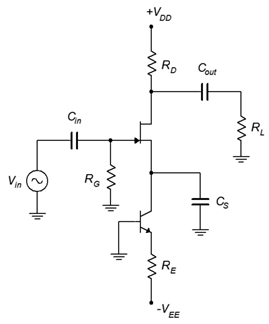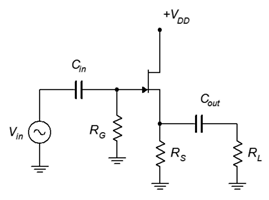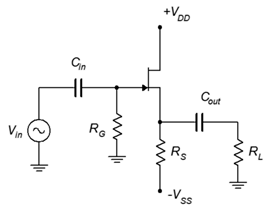11.8: Exercises
- Page ID
- 34252
11.8.1: Analysis Problems
1. For the amplifier of Figure \(\PageIndex{1}\), determine \(Z_{in}\) and \(A_v\). \(I_{DSS}\) = 12 mA, \(V_{GS(off)}\) = −2 V, \(V_{DD}\) = 15 V, \(R_G\) = 220 k\(\Omega\), \(R_D\) = 2 k\(\Omega\), \(R_L\) = 3.3 k\(\Omega\), \(R_S\) = 330 \(\Omega\).
2. For the amplifier of Figure \(\PageIndex{1}\), determine \(Z_{in}\) and \(V_{out}\). \(V_{in}\) = 50 mV, \(I_{DSS}\) = 15 mA, \(V_{GS(off)}\) = −3 V, \(V_{DD}\) = 20 V, \(R_G\) = 270 k\(\Omega\), \(R_D\) = 2 k\(\Omega\), \(R_L\) = 6.8 k\(\Omega\), \(R_S\) = 270 \(\Omega\).

Figure \(\PageIndex{1}\)
3. For the amplifier of Figure \(\PageIndex{2}\), determine \(Z_{in}\) and \(V_{out}\). \(V_{in}\) = 60 mV, \(I_{DSS}\) = 10 mA, \(V_{GS(off)}\) = −3 V, \(V_{DD}\) = 20 V, \(V_{SS}\) = −6 V, \(R_G\) = 270 k\(\Omega\), \(R_D\) = 2 k\(\Omega\), \(R_L\) = 4 k\(\Omega\), \(R_S\) = 1.8 k\(\Omega\), \(R_{SW}\) = 200 \(\Omega\).

Figure \(\PageIndex{2}\)
4. For the amplifier of Figure \(\PageIndex{2}\), determine \(Z_{in}\) and \(A_v\). \(I_{DSS}\) = 12 mA, \(V_{GS(off)}\) = −2 V, \(V_{DD}\) = 18 V, \(V_{SS}\) = −4 V, \(R_G\) = 330 k\(\Omega\), \(R_D\) = 2.2 k\(\Omega\), \(R_L\) = 10 k\(\Omega\), \(R_S\) = 3 k\(\Omega\), \(R_{SW}\) = 100 \(\Omega\).
5. For the amplifier of Figure \(\PageIndex{3}\), determine \(Z_{in}\) and \(A_v\). \(I_{DSS}\) = 12 mA, \(V_{GS(off)}\) = −2 V, \(V_{DD}\) = 18 V, \(V_{EE}\) = −4 V, \(R_G\) = 390 k\(\Omega\), \(R_D\) = 2.2 k\(\Omega\), \(R_E\) = 1 k\(\Omega\), \(R_L\) = 20 k\(\Omega\).

Figure \(\PageIndex{3}\)
6. For the amplifier of Figure \(\PageIndex{3}\), determine \(Z_{in}\) and \(V_{out}\). \(V_{in}\) = 70 mV, \(I_{DSS}\) = 12 mA, \(V_{GS(off)}\) = −2 V, \(V_{DD}\) = 18 V, \(V_{EE}\) = −4 V, \(R_G\) = 390 k\(\Omega\), \(R_D\) = 2.2 k\(\Omega\), \(R_L\) = 20 k\(\Omega\).
7. For the circuit of Figure \(\PageIndex{4}\), determine \(Z_{in}\) and \(A_v\). \(I_{DSS}\) = 12 mA, \(V_{GS(off)}\) = −2 V, \(V_{DD}\) = 10 V, \(R_G\) = 220 k\(\Omega\), \(R_L\) = 3.3 k\(\Omega\), \(R_S\) = 330 \(\Omega\).

Figure \(\PageIndex{4}\)
8. For the circuit of Figure \(\PageIndex{4}\), determine \(Z_{in}\) and \(V_{out}\). \(V_{in}\) = 200 mV, \(I_{DSS}\) = 15 mA, \(V_{GS(off)}\) = −3 V, \(V_{DD}\) = 12 V, \(R_G\) = 270 k\(\Omega\), \(R_L\) = 1.8 k\(\Omega\), \(R_S\) = 270 \(\Omega\).
9. For the circuit of Figure \(\PageIndex{5}\), determine \(Z_{in}\) and \(V_{out}\). \(V_{in}\) = 100 mV, \(I_{DSS}\) = 10 mA, \(V_{GS(off)}\) = −3 V, \(V_{DD}\) = 15 V, \(V_{SS}\) = −6 V, \(R_G\) = 470 k\(\Omega\), \(R_L\) = 4 k\(\Omega\), \(R_S\) = 1.8 k\(\Omega\).

Figure \(\PageIndex{5}\)
10. For the circuit of Figure \(\PageIndex{5}\), determine \(Z_{in}\) and \(A_v\). \(I_{DSS}\) = 18 mA, \(V_{GS(off)}\) = −2 V, \(V_{DD}\) = 14 V, \(V_{SS}\) = −6 V, \(R_G\) = 360 k\(\Omega\), \(R_L\) = 10 k\(\Omega\), \(R_S\) = 1 k\(\Omega\).
11. For the circuit of Figure \(\PageIndex{6}\), determine \(V_{out}\). \(V_{in}\) = 100 mV, \(r_{DS(on)}\) = 50 \(\Omega\), \(r_{DS(off)}\) = 1 M\(\Omega\), \(V_{GS(off)}\) = −3 V, \(V_C\) = −6 V, \(R_G\) = 270 k\(\Omega\), \(R_D\) = 6.8 k\(\Omega\).
12. For the circuit of Figure \(\PageIndex{6}\), determine \(V_{out}\). \(V_{in}\) = 100 mV, \(r_{DS(on)}\) = 75 \(\Omega\), \(r_{DS(off)}\) = 750 k\(\Omega\), \(V_{GS(off)}\) = −3 V, \(V_C\) = 0 V, \(R_G\) = 180 k\(\Omega\), \(R_D\) = 5.1 k\(\Omega\).

Figure \(\PageIndex{6}\)
11.8.2: Design Challenge Problems
13. Following the circuit of Figure \(\PageIndex{2}\), design an amplifier with a gain of at least 4 and an input impedance of at least 300 k\(\Omega\). \(R_L\) = 10 k\(\Omega\). The JFET has the following parameters: \(V_{GS(off)}\) = −2 V, \(I_{DSS}\) = 15 mA. Try to use standard resistor values.
14. Using the circuit of Figure \(\PageIndex{4}\), design a follower with a gain of at least 0.7 and an input impedance of at least 500 k\(\Omega\). \(R_L\) = 1 k\(\Omega\). The JFET has the following parameters: \(V_{GS(off)}\) = −3 V, \(I_{DSS}\) = 20 mA. Try to use standard resistor values.
11.8.3: Computer Simulation Problems
15. Utili\(Z_{in}\)g manufacturer's data sheets, find devices with the following specifications (typical) and verify them using the measurement techniques presented in the prior chapter. Device 1: \(V_{GS(off)}\) = −2 V, \(I_{DSS}\) = 15 mA. Device 2: \(V_{GS(off)}\) = −3 V, \(I_{DSS}\) = 20 mA.
16. Using the device model from the preceding problem, verify the design of Problem 13.
17. Using the device model from Problem 15, verify the design of Problem 14.


